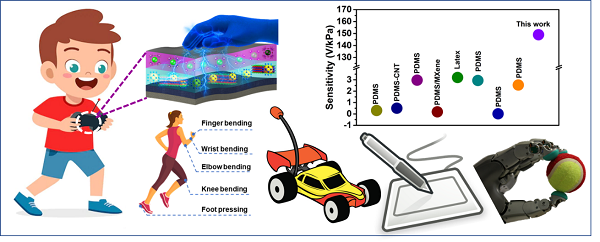Research On Zirconium metal-organic framework and hybridized Co-NPC@MXene nanocomposite-coated fabric for stretchable, humidity-resistant triboelectric nanogenerators and self-powered tactile sensors Got Featured On University Portal

High-performance triboelectric nanogenerators (TENGs) have become more attractive for energy harvesting and self-powered sensing applications. Herein, a stretchable, humidity-resistant, and high-performance multilayered TENG (M-TENG) is newly developed for self-powered biomotion and tactile sensing applications by using a zirconium metal-organic framework (MOF-525)@Ecoflex nanocomposite with a layer of Ecoflex@cobalt-nanoporous carbon (Co-NPC)@MXene. The MOF-525 improved TENG’s performance four times due to homogeneous porosity and high charge accumulation. The porous structure of the Co-NPC functions as charge traps, promoting high charge-trapping capability, while the MXene nanosheets operate as microcapacitors, improving transport-ions inside the Ecoflex@Co-NPC@MXene nanocomposite (charge-trapping and charge-transport). When the Ecoflex@Co-NPC@MXene nanocomposite was added as an intermediate layer, it captured triboelectric charges from the charge-generating layer and accumulated more negative charges, improving the M-TENG performance by 13 times. A 3D-printed microstructure is apprehended to the surface to increase contact area and humidity-resistant. Besides, knitted fabrics provide flexible electrodes due to their excellent stretchability. The as-prepared M-TENG showed excellent performance, including a power density of 25.7 W/m2, sensitivity (149 V/KPa), humidity-resistant, and stretchability (245%) which are superior to the previously reported TENGs. By exploiting the outstanding stretchability of the M-TENG and its ultra-high sensitivity to mechanical stimuli, practical applications were successfully demonstrated in low-frequency wearable biomotion monitoring, biomechanical energy harvesting, high-precision character recognition, and as a self-powered tactile sensor. Furthermore, the real-time sensing capability was demonstrated via the LabVIEW interface and virtual-reality car games control by tracing the finger. Therefore, this work is anticipated to open exciting opportunities for wearable energy harvesters, self-powered sensing systems, and human-machine interfaces.

Web Link:
https://doi.org/10.1016/j.nanoen.2022.107931
Article Link:
https://www.kw.ac.kr/ko/life/research.jsp?BoardMode=view&DUID=41761










